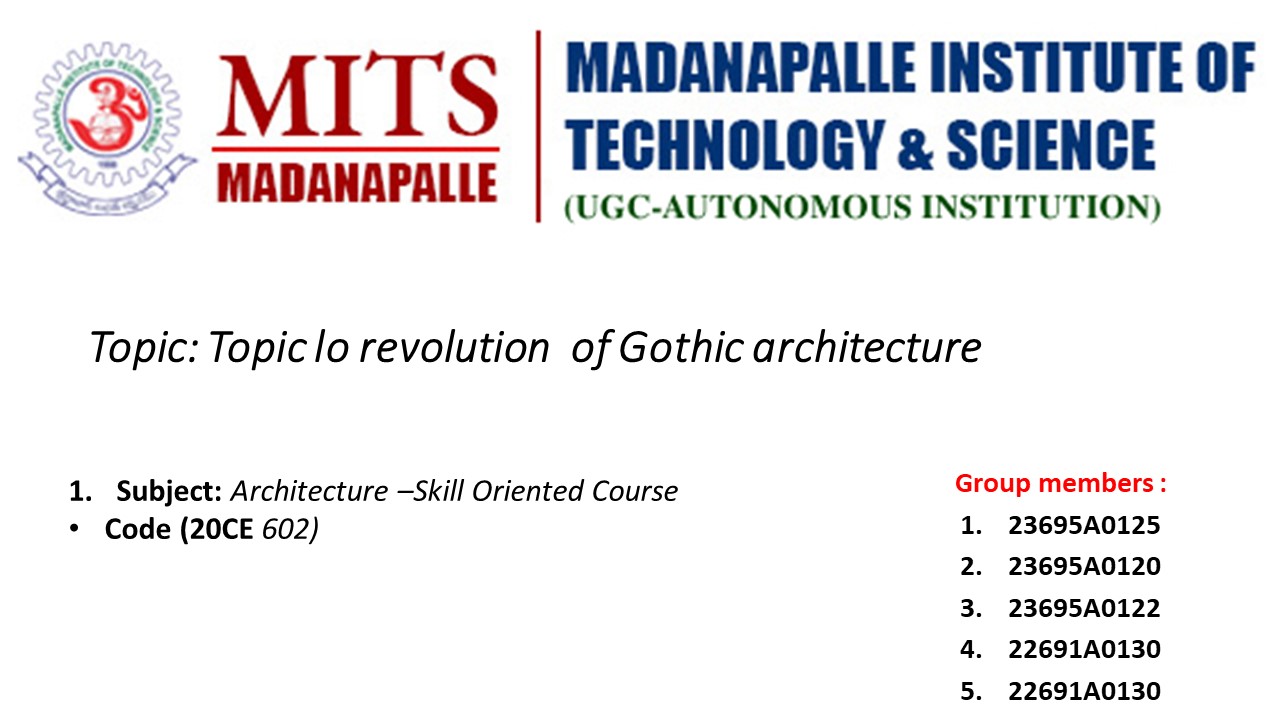Topic lo revolution of Gothic architecture - PowerPoint PPT Presentation
Title:
Topic lo revolution of Gothic architecture
Description:
A pointed arch, ogival arch, or Gothic arch is an arch with a pointed crown, whose two curving sides (thus yet another name, two-centred arch) meet at a relatively sharp angle at the top of the arch. This architectural element was particularly important in Gothic architecture. – PowerPoint PPT presentation
Number of Views:1
Title: Topic lo revolution of Gothic architecture
1
Topic Topic lo revolution of Gothic
architecture
- Group members
- 23695A0125
- 23695A0120
- 23695A0122
- 22691A0130
- 22691A0130
- Subject Architecture Skill Oriented Course
- Code (20CE 602)
2
- How do you identify Gothic architecture?
- While the Gothic style can vary according to
location, age, and type of building, - It is often characterized by 5 key architectural
elements - Large stained glass windows,
- Pointed arches,
- Rib vaults
- Flying buttresses, and
- ornate decoration
- The two major characteristics of the Gothic
cathedral are increased height and large
stained-glass windows.
3
What is a Gothic arch called?
- A pointed arch, ogival arch, or Gothic arch is an
arch with a pointed crown, whose two curving
sides (thus yet another name, two-centred arch)
meet at a relatively sharp angle at the top of
the arch. - This architectural element was particularly
important in Gothic architecture.
4
Is Gothic architecture still used today?
- Gothic architecture has fallen out of use in the
late 16th century and was replaced by a variety
of different movements and styles. - But it never died out, unlike most other
architectural styles. Its complexity makes it one
of the most sought after methods for high-end
buildings.
5
What does Gothic art look like?
- The art and architectural style that dominated
Western Europe during the medieval period. - Its buildings are characterised by
- pointed arches,
- strong vertical lines and
- elaborate window structures.
6
What is the legacy of Gothic architecture?
- The legacy of the Gothic style is
twofold decorative and innovative. - The architectural techniques developed during
the late medieval period not only made the Gothic
style architecturally possible, but paved the way
for the creation of tall, soaring buildings ever
since.
7
What are Gothic ceilings called?
- rib vault, in building construction, a skeleton
of arches or ribs on which masonry can be laid to
form a ceiling or roof. - Rib vaults were frequently used in medieval
buildings, most famously in Gothic cathedrals.
8
What are Gothic windows?
- rose window, in Gothic architecture, decorated
circular window, often glazed with stained glass.
9
But there are five characteristics of Gothic
architecture that stand out from other styles
- 1. Flying Buttresses
10
2. Pointed Arches The goal of using pointed
arches was to create more space by building
vertically.
11
3. Ribbed VaultsGothic structures are dominated
by high ceilings and large windows, and this was
possible by implementing ribbed vaults. Ribbed
vaults are not only visually stunning, but they
also create structural support for rounded roofs
by placing arches next to each other or in a
parallel fashion.
12
4. Large Stained-glass WindowsThese massive
windows were added as much for decoration as they
were to let in natural light.
13
5.Gargoyles and Ornate Decoration StoneDetailed
statues, columns, spires, pinnacles and the
trademark gargoyles are emblematic of Gothic
style.
14
Art and Gothic architecture
- Title The night mare
- Date1782
- By Henry Fuseli
- I think that this painting represents for Gothic
architecture Aru because gargoyles are suppose to
protect from evil and the gargoyles is protecting
the body from the evil spirit.
15
Gothic architecture and statues
- Date12th century
- Influence since the stained glass was
manitested as divine light ,it gave the church
more inspiration as a church.
16
(No Transcript)
17
Thank you for giving.
this opportunity Sir.

